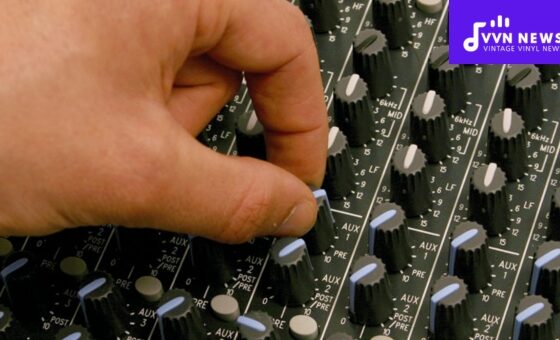As a dedicated music enthusiast, I’ve spent countless hours experimenting with sound and tones, searching for the perfect mix.
I’ve discovered the significance of equalization in shaping and molding songs to reach their full potential.
That’s why, from my vast experience and hands-on practice, I’ve distilled the essence into 25 mixing EQ tips to sculpt the perfect-sounding song that could make a difference to your final track.
Audio mixing can be likened to cooking – it’s all about finding the right blend of ingredients or frequencies to create the ideal sonic dish.
While it might appear daunting initially, the beauty lies in gradual learning and constant tinkering with sound elements.
With these 25 mixing EQ tips, you will be well-equipped to draw out beautiful details, add depth to the audio soundscape, and ultimately sculpt a well-defined and balanced masterpiece that resonates perfectly with your audience.
25 Mixing EQ Tips To Sculpt The Perfect Sounding Song
If you’ve always wondered about the secret sauce that brings alive a song, adds depth to its tones, and makes it universally likable, here it is – the journey of producing an impeccable track starts with understanding Equalization (EQ).
It’s an art as much as it’s a science, and when done right, EQ can help uplift your mix from good to flawless.
Here are some essential mixing EQ techniques to guide your quest for perfect sound.
Start with a flat EQ curve
The journey usually begins with no changes applied – often referred to as the “flat” setting.
Starting flat can provide a neutral starting point before you hone your tracks further to perfection.
When applying EQ to any given spectrum, a flat curve is the reference point that lets you judge which frequencies need to be adjusted and how they are intruding on or missing from your mix.
This approach helps minimize potential mishaps later in the process.
You might be tempted to start by boosting some frequencies that stand out immediately, but remember: adding more doesn’t always equate to greatness! This brings us naturally to our next tip.
Cut before boosting
A long-standing golden rule in audio mixing circles is this: cutting problematic frequencies can often sound more natural than boosting favorable ones.
Think again before we write this off as counterproductive (since we’re naturally inclined to enhance rather than decrease)!
Boosting might overemphasize some elements, leading to an artificial sound, while cutting invariably subtracts unnecessarily loud or harsh ingredients, contributing towards a masterpiece with smoother tonal balance.
Cut cautiously and precisely. Say there’s an offending frequency, making your vocal recording sound nasal.
You swoop in and swiftly reduce that specific range just enough until the problem gets solved – voila! A polished mix minus unwanted intrusions await you!
Use High-Pass Filters for Low-End Cleanup
High-pass filters are extremely crucial while EQ’ing. They allow frequencies above a specific point to pass through, drastically reducing the unneeded low-end frequencies in the mix.
It’s called ‘high-pass’ because it enables the higher frequencies to ‘pass through’ unfiltered and ‘block’ the sounds at the lower end of the spectrum.
This tool is perfect for cleaning up your track and giving it a more polished sound.
For instance, if you’re working on a vocal way or lead guitar with an unnecessary build-up of low-frequency information, a high-pass filter can sweep them out, freeing up headroom for elements requiring lower frequencies.
Avoid Excessive Boosts
While it might be tempting to keep boosting desired frequencies until they sound right to your ears, excessive boosting can often cause more harm than good.
Over-boosting risks distorting your sound and can cause an over-packed mix where every element fights for dominance and clarity gets lost.
Even when you find something that needs fixing, cutting unwanted frequencies will often prove more valuable than boosting desirable ones.
Tame Harshness with a Wide Q
Harshness within your mix can be brought down a notch using a wide Q (Quality factor).
This means making broader EQ adjustments rather than precise boosts or cuts.
A wide Q acts gently across various nearby frequencies rather than on one specific frequency spot, reducing the abrupt variation and unnatural sound peaks.
In other words, a wide Q can help in smoothing out many of those harsh peaks that can occur across multiple frequencies without damaging different adjacent frequencies.
Narrow Q for Surgical Cuts
Conversely, a narrow Q allows you to perform “surgical” procedures on your sound.
A little Q is beneficial in eliminating problematic frequencies without affecting most of the surrounding spectrum.
A narrow Q presents a tighter frequency range, which is excellent for precise cuts that target particular frequencies.
Applying these sharp cuts can significantly clean up individual tracks and overall mixes without causing any substantial impact on the overall tone of your song.
These EQ techniques are powerful tools as long as they are utilized thoughtfully and with clear intent.
Trust Your Ears, Not The Numbers
Sometimes, the numbers on the mixing console may tell you that everything should be alright, yet something sounds off. Here is where trusting your ears becomes crucial.
This doesn’t imply that mixing techniques and their principles hold no weight, but sometimes, what sounds pleasant to the ears doesn’t necessarily have to follow established rules.
Give precedence to your instinct to detect frequency discrepancies as a sound engineer or producer.
Don’t permit the numbers on your EQ plugin or outboard gear to manipulate your decision because what matters is what comes out of the speakers. Listen attentively and let your ears guide your mixing decisions.
Prioritize Fixing Issues Over Enhancing
Before diving headfirst into sonic enhancements, focus on nailing down anomalies in the soundtrack.
It can be tempting to begin tweaking tones and adding effects for more pallets, but try resisting this urge until you’ve addressed any glaring issues first.
The top priority should be eliminating noisy artifacts or frequency masking – correcting these problems will pave a smoother way for embellishments.
Emphasize achieving a clean, balanced mix that allows every component within a track to manifest clearly before further augmenting it.
Use Shelving Filters for Broad Adjustments
Shelving filters can play an instrumental role in equalizing an entire portion of the frequency spectrum, either from low-end (Low Shelf) or high-end (High Shelf).
These filters are handy if you need substantial changes without producing too much resonance or an unnatural tone.
For instance, if a track needs more clarity and shines overall, applying a High Shelf filter at around 6 kHz could uplift all high-end frequencies simultaneously.
Conversely, lowering high frequencies with a High Shelf could warm up the overall tonal balance if a mix feels excessively bright and sharp.
Cut Unwanted Resonances
Occasionally, you might encounter undesirable resonant frequencies that ruin the final sound while recording or mixing synth tracks.
These are audible as a constant ringing or humming in the back of your mix and can divert focus away from essential elements or cause ear fatigue for listeners.
Notch filters or band-reject filters can come to the rescue to handle this. They allow you to cut a narrow frequency band while leaving the frequencies unaffected on either side.
Employ a narrow EQ cut using these filters to attenuate the problematic frequency and restore harmony in your mix.
Don’t Over-EQ Individual Tracks
Mixing EQ shouldn’t be used to transform the sound of individual tracks radically.
We often get carried away in the mixing process, feeling the urge to tweak every track separately and dramatically.
But it’s critical to maintain the essence of each sound and not strip away its unique qualities.
Overuse of EQ can lead to a thinner, more unnatural audio mix. If a track requires drastic EQ changes, it might be worth re-recording the way or substituting it with a better-fitting path.
For instance, excessive cutting from a vocal can make it seem thin or weak, while over-boost can cause specific frequencies to dominate over others.
It’s about creating balance; use EQ as a tool not just to isolate trouble frequencies but to make them work harmoniously within your mix.
Check Your Mix in Mono
While creating in stereo gives you a vast sound field to work with, sometimes less is more. Make it a habit to constantly check your mixes in mono because if your mix can shine through even in mono, you’ve crafted an impactful song that will be resilient across various listening devices.
Checking your mix in mono is also an effective way of revealing phase issues or frequency clashes that may go unnoticed in stereo mode.
Mono compatibility Ensures that your mix sounds balanced on all types of speaker systems, from high-end stereo speakers to phone speakers.
Create Separation with EQ
In densely layered soundscapes with numerous elements fighting for space, EQ is instrumental in carving out their unique space within the frequency spectrum.
By tailoring each instrument’s tone within this space—boosting one sound source while reducing another—the result is a harmonious balance where everything fits together like pieces of a puzzle with no two tones stepping on each other’s toes.
Visualize the frequency spectrum as assigned seating at an elaborate dinner party. You wouldn’t want attendees occupying the same seat.
Use EQ to “seat” your various sound elements appropriately across the frequency spectrum, thus creating a flavourful sonic blend.
Beware of Phase Issues with EQ
While EQ potentiates individual tracks, beware of potential phase issues.
Adjusting an EQ setting can change the phase of specific frequencies, leading to gaps or peaks in those frequencies.
Phase problems typically emerge when multiple microphones capture the same source or when processing audio stereo tracks.
This can make certain sounds seem muddy or disappear entirely when summing to mono.
Strategies such as using linear-phase EQ plugins or delaying specific channels might be necessary to avoid the risk of phase cancellation.
Remember, EQ adjustments should enhance and not adversely affect your audio mix.
Use Mid-Side EQ for Wider Mixes
Mid-side EQ might initially seem intimidating, but using it efficiently can allow you to create more comprehensive mixes.
In traditional stereo mixing, you have a left and right channel (also referred to as ‘sum’), which gives the listener an illusion of space and direction when combined.
Mid-side EQ takes this a step further. ‘Mid’ refers to sounds in the center – in other words, all the elements of your mix which are identical in both speakers. ‘Side,’ on the other hand, represents different elements in each speaker.
When you apply mid-side EQ adjustments, you handle sounds in their entirety or only those placed wide in the stereo field.
This ability lets you widen your mix while maintaining mono compatibility, providing richer soundscapes.
Match the EQ Style to The Source
Different sources demand different EQ styles. For example, while working on a snare drum that lacks punch, a slight boost in the lower mid-range might be effective.
Conversely, if you’re sculpting vocals to sound brighter, attenuating some mid-range frequencies and slightly boosting the higher range can achieve a pleasing result.
You must listen to your source material carefully first, understand its spectral content, and then decide which style of EQ will be best suited.
For instance, graphic EQs work wonders on overall tone shaping, while parametric EQs are remarkable for their surgical precision.
Use EQ Sparingly on The Master Bus
The Master Bus is where all your tracks come together. Therefore, it raises an urge to over-EQ it due to an extensive range of frequencies present at this stage.
However, subtlety is key. You need to apply EQ here with care, ensuring you do not upset the balance of your mix.
Any adjustments made at this stage are global and affect the entire song. The focus should be more on gentle shifts that glue the mix together rather than drastic moves involving individual instruments or voices.
Experiment with EQ Order
Believe it or not, the order in which you place your EQ can significantly impact your final sound.
Think about it as flavoring layers in a dish – spice first or last? The order matters!
Suppose you add an EQ before a compressor in your signal chain (pre-compression).
In that case, you will affect how that compressor reacts because altering frequencies affects how loud they appear to the compressor, which then responds accordingly.
But suppose you add after (post-compression). In that case, your compressor won’t be affected by any changes you make with your EQ, making it easier for you to shape sounds without interfering with dynamics processing.
Automate EQ for Dynamic Changes
In the world of mixing and mastering music, automation is a game-changer.
This feature allows adjustments to your Equalizer (EQ) settings to happen seamlessly as your track progresses, providing you with finely tuned dynamic changes.
Automating EQ can enhance the emotional impact of your song and create an engaging sonic journey when done correctly.
Consider the complex interplay between frequencies in different parts of your music when automating EQ.
You might find that certain parts demand more accentuation or subtle tones – automating the EQ lets you address these variations throughout the song.
Master EQ Should Be Subtle
When it comes to mastering EQ, subtlety is indeed a virtue. The aim here is not radical alteration but gentle refinement.
Remember, less is more in this stage. While it may be tempting to delve into drastic equalization adjustments in mastering, making vast changes could destroy the meticulous mix already in the mixing stage.
Instead, treat Mastering EQ as a tool for fine-tuning. A soft touch often produces better results – think minor tweaks rather than vast alterations – thus creating a coherent and balanced sonic landscape without disrupting individual elements’ integrity.
Don’t EQ for The Sake of EQ
Implementing equalization should always serve a specific purpose- brightening dull vocals, adding punchiness to drums, or taming harsh guitar tones.
With countless options available on modern-day music production software, there lies an easy trap of overworking your mixes because you can.
Therefore, if a particular track sounds good without applying any EQ tweaks, then there’s no need for unnecessary adjustments.
This mantra creates room for other elements within your mix that may require more attention to maneuver comfortably in the frequency spectrum.
Monitor Different Volumes
The intriguing part about mixing at different volumes is how our ears perceive sound.
At low volumes, our ears are less sensitive to very high and very low frequencies; on the other hand, we hear these frequencies more clearly at higher volumes.
This is known as the “Fletcher-Munson Curve”— an essential concept to grasp for any aspiring producer or engineer.
Adjusting your monitors at different volumes can reveal issues that aren’t immediately apparent at a single volume level.
Learn To Use Parametric EQ
Parametric EQ is arguably one of the most versatile forms of equalization. It allows you to select any frequency you want to adjust and provides controls for gain (boost/cut), frequency (determines which frequency you’re affecting), and Q (how broad or narrow your adjustments will be).
Using a parametric EQ effectively requires an intimate understanding of how frequencies interact in your mix — it’s an essential tool in every audio engineer’s belt.
A/B Test Your EQ Changes
A/B testing is a method of comparing two versions of a mix to determine which one performs better.
It involves alternating between the original mix (A) and the equalized version (B) to evaluate the changes you’ve made objectively.
This technique can prevent unnecessary tweaking and helps keep perspective – after prolonged mixing periods, our ears can become desensitized or used to certain sounds that may cause us to lose objective judgment.
Trust Your Instincts
Finally, while all these tips contribute much-needed technical know-how for achieving quality sound, there’s another factor that plays an equally important role – your instincts.
As crucial as it is to understand the science behind mixing and mastering, music remains a creative endeavor.
So, learn about equalization, grasp these tips, and dare to venture from them when your gut tells you so.
As renowned mix engineer Dave Pensado said, “If it sounds good, it is good.”
FAQs About Mixing Eq
What is the importance of using a flat EQ curve when mixing?
A flat EQ curve allows for an unbiased listening perspective of the track. This ensures that you aren’t making decisions based on exaggerated frequencies.
How can I avoid phase issues with EQ?
To avoid phase issues, refrain from applying extreme boosts or cuts, especially on low frequencies, as they can cause timing discrepancies, leading to phase cancellation.
Why is it important to listen to my mixes in mono?
Listening to mixes in mono allows you to hear any potential phase cancellation or frequency masking. It’s a technique that can improve the clarity and balance of your mix.
Can you explain what a high-pass filter is for?
A high-pass filter lets high frequencies pass through while reducing lower frequencies. It’s often used in mixing to clean up unnecessary low-end noise on non-bass instruments.
Should I always apply EQ on every track?
No, not necessarily. Each application of EQ should serve a purpose, whether rectifying an issue or enhancing a positive aspect. Overuse can lead to an unnatural-sounding mix.
Conclusion
After carefully assimilating these 25 mixing EQ tips, it is essential to remember that the end goal is to find that perfect blend that is uniquely yours.
Don’t be afraid to experiment and make mistakes; refine your technique with each try.
Remember, every song is different; this creative pursuit has no hard and fast rules.
Your workspace is your playground – so dive in, start mixing, and pay heed to these gems of wisdom as you sculpt your perfect-sounding song!







